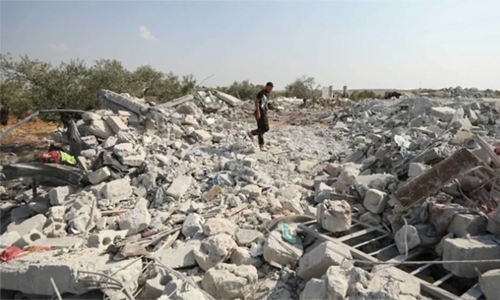Baghdadi: a trail of horror and death
Baghdadi has long been a target for US and regional security forces trying to eliminate Islamic State, even as they reclaimed most of the territory the group once held. The Islamic State or caliphate that Baghdadi declared in July 2014 over a quarter of Iraq and Syria was notable for atrocities against religious minorities and attacks on five continents in the name of a version of an ultra-fanatic Islam that horrified mainstream Muslims. The genocide of Yazidis, adherents of one of the Middle East’s oldest religions, illustrated the brutality of his rule.
Thousands of men were slaughtered on their ancestral Sinjar mountain in northwestern Iraq and women were killed or taken as sex slaves. Some other religious groups suffered sexual slavery, slaughter and floggings. The group also caused global revulsion with beheadings of hostages from countries including the United States, Britain and Japan. The United States put up a $25 million reward for his capture, the same amount as it had offered for al Qaeda leader Osama bin Laden and his successor Ayman al-Zawahri. US air strikes have killed most of Baghdadi’s top lieutenants, including Abu Omar al-Shishani, Abu Muslim al-Turkmani, Abu Ali al-Anbari, Abu Sayyaf and the group’s spokesman Abu Mohammed al-Adnani.
Thousands of his fighters were also killed or captured. Baghdadi was born Ibrahim Awad al-Samarrai in 1971 in Tobchi, a poor area near the town of Samarra, north of the Iraqi capital Baghdad, whose name he took. His family includes preachers from the ultra-conservative Salafi school of Sunni Islam, which sees many other branches of the faith as heretical and other religions as anathema. He joined the Salafi jihadist insurgency in 2003, the year of the US-led invasion of Iraq, and was captured by the Americans.
They released him about a year later, thinking he was a civilian agitator rather than a military threat. It was not until July 4, 2014, that he seized the world’s attention, climbing the pulpit of Mosul’s medieval al-Nuri mosque in black clerical garb during Friday prayers to announce the restoration of the caliphate. “God ordered us to fight his enemies,” he said in a video of the occasion, which presented him as “Caliph Ibrahim, commander of the faithful”.
Thousands of volunteers flocked into Iraq and Syria from around the world to become “Jund al-Khilafa” — soldiers of the caliphate and join him in his fight against the Shi’ite-led Iraqi government and its U.S. and Western allies. Most of Baghdadi’s speeches were distributed as audio recordings, a medium better suited to the secretive, careful character that for a long time helped him evade the surveillance and air strikes that killed more than 40 of his top commanders.
That caution was matched by ruthlessness as he eliminated opponents and former allies, even within Salafi jihadist ranks. He waged war on al Qaeda’s Syrian wing, the Nusra Front, breaking with the movement’s global leader, al-Zawahri, in 2013. But by the time of the raid against him this weekend, his fortunes - and those of Islamic State - were in rapid decline.
Still a threat
In his most recent audio message, in September, Baghdadi put on a brave face, saying operations were taking place daily and urging followers to secure freedom for women jailed in Iraq and Syria over their alleged links to the group. “As for the worst and most important matter, the prisons, the prisons, oh soldiers of the caliphate. Your brothers and sisters; do your utmost to free them and tear down the walls restricting them,” Baghdadi said.
But the loss of territory in Iraq and Syria stripped him of the trappings of caliph and made him a fugitive in the desert border area between the two countries. He was forced to travel incognito in ordinary cars or farm pick-up trucks between hideouts on both sides of the border, escorted only by his driver and two bodyguards. Fearing assassination or betrayal, he has not been able to use phones and trusted only a handful of couriers to communicate with his two main Iraqi aides, Iyad al-Obaidi, his defence minister, and Ayad al-Jumaili, his security chief.
The two have been believed to be among the likely candidates for his succession, but Jumaili was killed in April 2017 and Obaidi’s whereabouts are unknown. In any case, their military background and lack of religious credentials mean that any of Baghdadi’s deputies would struggle to inherit his claims to be caliph if he has been killed.
Related Posts

